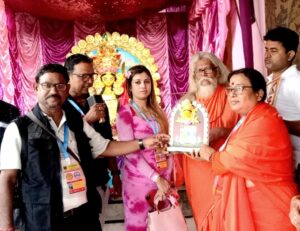News Stardom : Kolkata, l aSOMNOS SLEEP CLINIC, KOLKATA in association with ORANGE SLEEP APNEA
CLINIC & WORLD SLEEP SOCIETY.
World Sleep Day 2020 will incorporate the slogan, ‘Better Sleep, Better Life, Better Planet,’ highlighting sleep’s important place as a pillar of health, allowing for better decision making and cognitive understanding in even big issues, such as our planet. This focus is purposefully broad in meaning, surrounding the message that quality of life can be improved with healthy sleep. Conversely, when sleep fails, health declines, decreasing
quality of life. Sound sleep is a treasured function. World Sleep Society has compiled ten tips for healthier sleep. These recommendations for children and adults can be viewed on
worldsleepday.org under resources.
A man spends one third of his life sleeping. Yet, strangely, sleep is mostly neglected in our everyday lives. When we are young, we study and work sacrificing our sleep at the slightest pretext, often curtailing sleep for that extra hour of work/ studies. When we grow old, we try to fall asleep at any cost and use and abuse sedatives in the process. Sound sleep is a treasured function and one of the core pillars of health. When sleep fails, health
declines, decreasing quality of life. Sleep and energy balance are essential for health. During sleep, energy is conserved due to suspended activity, movement, and sensory responses, and is redirected to restore and replenish proteins and their assemblies into cellular structures. Sleep also serves the very important function of information processing and memory consolidation.
Sleep problems constitute a global epidemic that threatens health and quality of life for up to 45% of the world’s population. Three elements of good quality sleep are:
Duration: The length of sleep should be sufficient for the sleeper to be rested and alert the following day. Continuity: Sleep periods should be seamless without fragmentation.
Depth: Sleep should be deep enough to be restorative. There are close to one hundred sleep disorders known to mankind and fortunately most of these
are preventable or treatable. The most common ones are insomnia, obstructive sleep apnea and restless leg syndrome. In India, the prevalence of obstructive sleep apnea is 13.7%. OSA is an independent risk factor
for hypertension and other cardiovascular ailments and untreated sleep apnea may lead to heart
diseases, stroke, diabetes, obesity, impotence and vascular dementia. In children, sleep apnea may be the underlying cause of neuropsychological disturbances.
Both adults and children should be formally investigated in sleep centres if sleep apnea is suspected, because both adult and pediatric sleep apnea is treatable and correctable; a correct
and precise diagnosis is always required. Sleep apnea is diagnosed with level 1 fully attended polysomnography in the sleep laboratory consisting of atleast 7 EEG, 2 EMG leads apart from the others leads like airflow, ECG, oximetry etc. It is very important to get the study data manually scored by a certified sleep
specialist or sleep technician for correct interpretation of results which paves the way for correct diagnosis and treatment. Portable home sleep studies miss out on EEG leads or have only 1-2
EEG leads which make recognizing the various sleep wake stages inaccurate and difficult. Computerised/ automatic scoring can’t recognize the EEG waves correctly and hence often lead
to inappropriate results and thus faulty diagnosis. Treatment with non-invasive positive airway (continuous positive airway pressure, or CPAP)
ventilation is generally successful. Surgery to remove excessive tissues in the oropharynx may be considered for individuals who cannot tolerate non-invasive equipment or who have obvious obstruction to airflow in the oropharynx by redundant tissue growth or large tonsils, and is
particularly helpful for children with OSA. There is proof that successful correction of sleep apnea with non-invasive positive airway pressure ventilation lowers mean blood pressure and may reduce the risk of myocardial infarction and stroke. Excessive daytime somnolence generally improves with successful treatment of sleep apnea. Insomnia affects around 35-40% of the general adult population. Lack of sleep or poor quality
sleep also leaves us more vulnerable to accidents causing death or serious injury. Those with insomnia suffer from more symptoms of anxiety and depression and can affect work
performance and have a general negative impact in all areas life including reduced job prospects
and loss of emplo Restless Legs Syndrome is a common disorder and occurs in between 3-10% of the population, and is characterised by a vague and difficult-to-describe unpleasant sensation in the legs worse
at rest and at night and relieved by movement or massage. If untreated, it impairs daytime functioning, productivity and can increase risk of depression, hypertension, kidney and heart diseases.
• PRINCIPLES OF GOOD SLEEP
Following the guidelines of Sleep Hygiene can help to prevent poor quality nocturnal sleep, short duration of sleep, fragmentation of sleep and serious sleep deprivation in adults.
10 COMMANDMENTS OF SLEEP HYGIENE FOR ADULTS
1. Fix a bedtime and an awakening time.
2. If you are in the habit of taking siestas, do not exceed 45 minutes of daytime sleep.
3. Avoid excessive alcohol ingestion 4 hours before bedtime and do not smoke.
4. Avoid caffeine 6 hours before bedtime. This includes coffee, tea and many sodas, as
well as chocolate.
5. Avoid heavy, spicy, or sugary foods 4 hours before bedtime. A light snack before bed
is acceptable.
6. Exercise regularly, but not right before bed.
7. Use comfortable bedding.
8. Find a comfortable temperature setting for sleeping and keep the room well ventilated.
9. Block out all distracting noise and eliminate as much light as possible.
10. Reserve the bed for sleep and sex. Don’t use the bed as an office, workroom or recreation room.
10 COMMANDMENTS OF SLEEP HYGIENCE FOR CHILDREN [AGES BIRTH TO 12 YEARS]
1. Go to bed at the same time every night, preferably before 9:00PM.
2. Have an age-appropriate nap schedule.
3. 3. Establish a consistent bedtime routine.
4. Make your child’s bedroom sleep conducive – cool, dark, and quiet.
5. Encourage your child to fall asleep independently.
6. Avoid bright light at bedtime and during the night, and increase light exposure in the morning.
7. Avoid heavy meals and vigorous exercise close to bedtime.
8. Keep all electronics, including televisions, computers, and cell phones, out of the bedroom and limit the use of electronics before bedtime.
9. Avoid caffeine, including many sodas, coffee, and teas (as well as iced tea).
Keep a regular daily schedule, including consistent mealtimes.
13th WORLD SLEEP DAY: 13 MARCH 2020 SOMNOS SLEEP CLINIC, KOLKATA
More from GeneralMore posts in General »
- MSP PARIVAAR ON THE EVE OF DIWALI STRESSED ON HEALTHY BONDINGS….
- জন্মগত হৃদরোগে আক্রান্ত ২৬ বছরের যুবকের নতুন আশার আলো দিলেন ডাক্তার নুরুল ইসলাম এবং তার টীম এক যুগান্তকারী পদ্ধতির মাধ্যমে: Transcatehter Pulmonary Valve Implantation অথবা টিপিভিআই (TPVI)…..।
- বদ্রীনারায়ণের চরণ ছুঁয়ে কল্পেশ্বরের আশীষ নিতে নতুন এক ট্রেক পথে এসে পৌঁছলেন কলকাতার দ্য ইনস্টিটিউট অফ এক্সপ্লোরেশনের ৫ সদস্যের দল…..।
- রাজ্য জুড়ে বিএসইউয়ের মাধ্যমিক ও উচ্চ মাধ্যমিকের ‘প্রয়াস মক টেস্ট’….।
- বেনারসে মহা ধুমধামের সাথে আয়োজিত হচ্ছে ভারত সেবাশ্রম সঙ্ঘের দুর্গা পুজো….।
- এ এস এস নিউজ ওয়ান ও অন্যান্য মিডিয়া পার্টনারদের পক্ষ থেকে বঙ্গ দিশারী শারদ সন্মান- ২০২৪….।






Be First to Comment